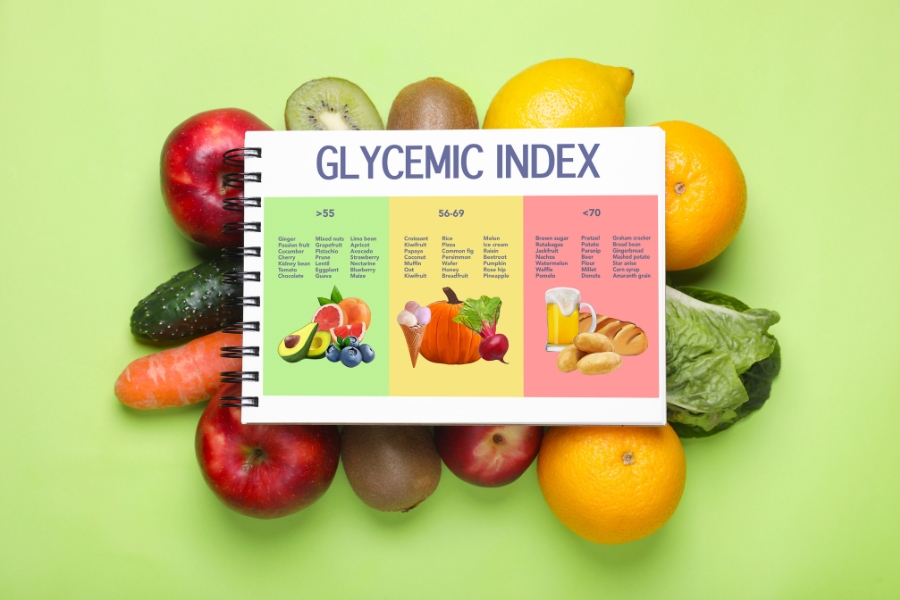
Low Glycemic Index Foods for Type 2 Diabetes
Table of Contents
ToggleUnderstanding the glycemic index and its importance for managing type 2 diabetes
The glycemic index is a system that ranks foods on a scale from 0 to 100 based on how much they raise blood sugar levels after eating. Foods with a high glycemic index are often digested and absorbed quickly, causing blood sugar levels to increase quickly. Conversely, low GI foods have a slower digestion and absorption rate, leading to a gradual increase in blood sugar.
For individuals like myself, managing type 2 diabetes, keeping blood glucose levels stable is crucial. Sudden spikes and drops can not only be dangerous in the short term but can also contribute to long-term complications. Integrating low GI foods into my diet has been a fundamental strategy in controlling my blood sugar and maintaining a healthy lifestyle.
Understanding the GI of different foods enables me to make choices that align with my health goals. Whether I’m at the grocery store or dining out, I have the information needed to select foods that will support my blood sugar management. This empowerment is a cornerstone of living well with diabetes.
What is a low glycemic index (GI) food?
A low glycemic index food is one that is ranked 55 or less on the GI scale. These foods are digested more slowly, causing a lower and more gradual rise in blood glucose levels. Examples include most fruits and vegetables, whole grains, legumes, nuts, and seeds. When incorporating these foods into my diet, I have noticed that they tend to keep me fuller for longer and provide sustained energy without the blood sugar roller coaster.
Choosing low GI foods is about more than just the number, though. It’s about understanding how different foods interact with my body and can affect my diabetes. It’s not an exact science, as individual responses can vary, but it has been a reliable guideline for me. It’s also important to note that the GI does not measure portion size or nutritional content, so it’s only one part of the puzzle in creating a balanced diet.
When I first learned about low GI foods, I started reading labels more closely and paying attention to the types of carbohydrates in my meals. It was a bit overwhelming at first, but with time, it became second nature. Now, I can easily spot low GI foods and incorporate them into my diet without much thought.

The benefits of incorporating low GI foods into a type 2 diabetes diet
Incorporating low GI foods into my diet has had a multitude of benefits. Firstly, these foods help in maintaining glycemic control, which is critical for managing diabetes. By avoiding high GI foods that cause rapid blood sugar spikes, I can keep my glucose levels within a target range, reducing the risk of hyperglycemia.
Secondly, low GI foods tend to be more nutrient-dense, providing vitamins, minerals, and fibers that are beneficial for overall health. This nutrient density supports a healthy weight, which is often a concern for individuals with type 2 diabetes. Maintaining a healthy weight can improve insulin sensitivity and make diabetes management more effective.
Lastly, a diet rich in low GI foods aligns with recommendations for a healthy eating pattern for the general population, not just those with diabetes. This means that adopting such a diet can improve my health beyond just blood sugar control. It can lower my risk for other chronic diseases, such as heart disease, and contribute to a more balanced and healthful lifestyle.
Quinoa: benefits, uses, recipes and dosage for people with type 2 diabetes
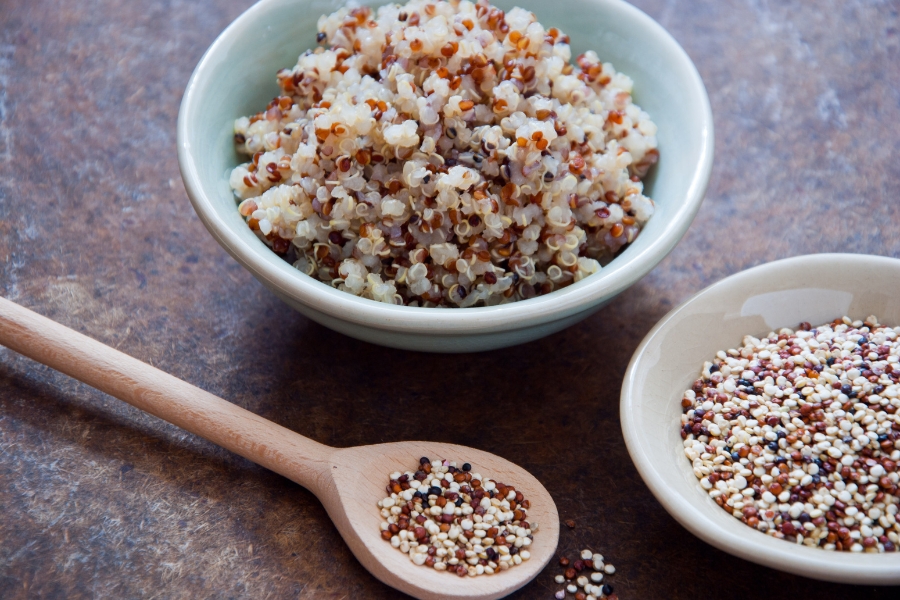
Quinoa benefits, uses, recipes and dosage for people with type 2 diabetes
What is Quinoa?
Quinoa (pronounced kee-NO-ah) isn’t technically a grain, but a seed from the Chenopodium family, related to amaranth and beets. Native to South America, it’s known for its complete protein content and various health benefits, making it a valuable addition to the diet, especially for individuals with type 2 diabetes.
Benefits for Type 2 Diabetes:
- High in Fiber and Protein: Compared to many grains, quinoa boasts a higher content of both fiber and protein. Fiber slows down digestion and carbohydrate absorption, leading to a steadier rise in blood sugar levels. Protein contributes to satiety, promoting feelings of fullness and potentially reducing cravings and overeating, both beneficial factors for diabetes management.
- Low Glycemic Index (GI): With a GI around 53, quinoa falls into the “low” category, meaning it causes a slower and smaller rise in blood sugar compared to high-GI foods like white rice or bread. This helps maintain better blood sugar control, crucial for individuals with type 2 diabetes.
- Gluten-free: Quinoa is naturally gluten-free, making it a safe and healthy alternative for individuals with type 2 diabetes who also have celiac disease or gluten sensitivity.
- Rich in Essential Nutrients: Quinoa is a good source of vitamins and minerals like B vitamins, magnesium, iron, and manganese, which play vital roles in various bodily functions impacted by diabetes, including metabolism and energy production.
Uses for Type 2 Diabetes:
- Substitute refined grains: Replace white rice, pasta, or bread with quinoa in your meals to lower the overall glycemic load of your diet.
- Incorporate into salads and bowls: Quinoa’s versatility allows it to be added to salads, bowls, and stir-fries, providing a source of protein, fiber, and essential nutrients.
- Use as a breakfast porridge: Cook quinoa with milk or water and add nuts, seeds, and fruits for a nutritious and filling breakfast option.
- Experiment in baking: Quinoa flour can be used in various baking recipes, offering a gluten-free alternative with added protein and fiber.
Important Note: While quinoa offers numerous benefits, remember to manage your overall diet and consult a healthcare professional or registered dietician for personalized dietary recommendations based on your specific needs and medical history. They can advise on appropriate portion sizes and guide you in creating a balanced meal plan incorporating quinoa effectively.
Recipes for People with Type 2 Diabetes:
- Mediterranean Quinoa Salad: Combine cooked quinoa with chopped vegetables like cucumber, tomatoes, olives, and crumbled feta cheese. Dress with a light vinaigrette.
- Black Bean and Quinoa Stuffed Peppers: Bell peppers are stuffed with a mixture of cooked quinoa, black beans, corn, and spices, then baked until tender.
- Quinoa and Chicken Stir-fry: Stir-fry chicken strips with vegetables like broccoli, carrots, and bell peppers. Add cooked quinoa and a low-sodium soy sauce or teriyaki sauce for flavor.
Dosage:
It’s crucial to understand that “dosage” isn’t typically used for whole foods like quinoa. Instead, portion control and overall dietary context are key for individuals with type 2 diabetes. Your healthcare professional or registered dietician can help determine the appropriate amount of quinoa to include in your meals based on your individual needs and calorie requirements. They can also advise on building a balanced meal plan incorporating quinoa alongside other healthy food choices.
Lentils: benefits, uses, ways and dosages for people with type 2 diabetes
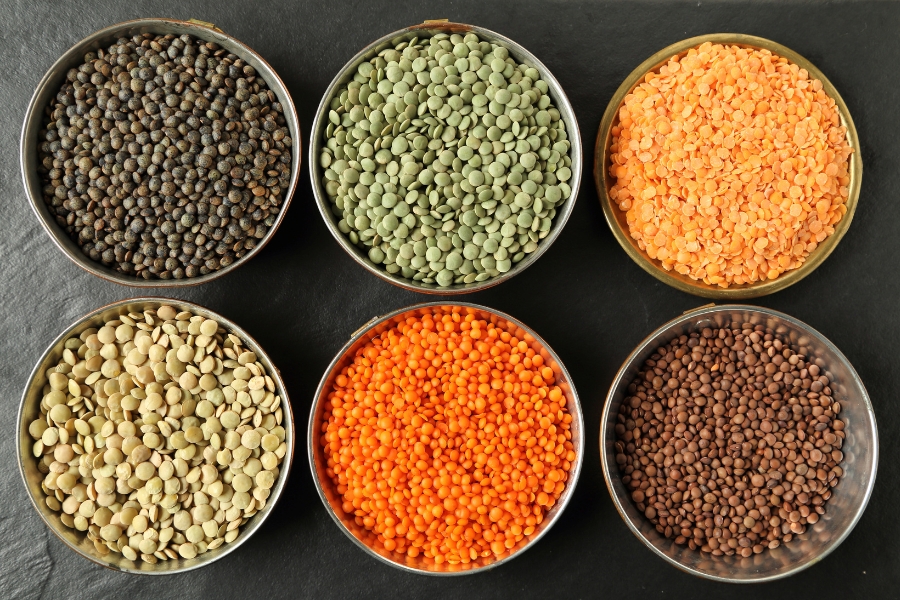
Lentils: benefits, uses, ways and dosages for people with type 2 diabetes
Lentils are a type of legume, similar to beans and peas, that come in various colors like brown, green, red, and black. They are a nutritional powerhouse, packed with essential nutrients like:
- Fiber: Lentils are a great source of both soluble and insoluble fiber. Soluble fiber helps slow the absorption of sugar into the bloodstream, which is beneficial for blood sugar control in people with type 2 diabetes.
- Protein: Lentils are a good source of plant-based protein, which can help with feeling full and satisfied, potentially reducing calorie intake and aiding in weight management, a crucial factor in diabetes control.
- Resistant starch: Lentils also contain resistant starch, a type of fiber that acts like a prebiotic, feeding the beneficial gut bacteria and promoting gut health, which may have a positive impact on overall health, including diabetes management.
- Vitamins and minerals: Lentils are a good source of various vitamins and minerals, including folate, iron, magnesium, potassium, and zinc, all of which are essential for overall health and well-being.
Benefits of Lentils for Type 2 Diabetes:
- Blood sugar control: Studies have shown that consuming lentils can help improve blood sugar control in people with type 2 diabetes. The combination of fiber, protein, and resistant starch in lentils appears to slow down the absorption of sugar into the bloodstream, leading to more stable blood sugar levels.
- Weight management: As mentioned earlier, the fiber and protein content in lentils can help with feeling full and satisfied, potentially reducing calorie intake and aiding in weight management, which is crucial for managing type 2 diabetes.
- Heart health: Lentils may also help improve heart health in people with type 2 diabetes. Studies have shown that they can help lower bad (LDL) cholesterol and triglycerides, while increasing good (HDL) cholesterol.
- Overall health: The various vitamins and minerals in lentils are essential for overall health and well-being, which is especially important for people with diabetes who are at an increased risk for various complications.
Using Lentils for Type 2 Diabetes:
Lentils are a versatile ingredient that can be incorporated into various dishes, making it easy to add them to your diet. Here are some ways to use lentils:
- Soups and stews: Lentils are a hearty and nutritious addition to soups and stews.
- Salads: Cooked lentils can be added to salads for a boost of protein and fiber.
- Dips and spreads: Lentils can be mashed and used to make dips and spreads.
- Main dishes: Lentils can be used to make vegetarian burgers, meatballs, and other main dishes.
Dosage and Recommendations:
It is recommended to gradually increase your intake of lentils to allow your digestive system to adjust. Start with a small amount, such as 1/4 cup cooked lentils, and gradually increase to 1/2 cup or 3/4 cup per day. It is important to note that everyone’s individual needs may vary, so it is best to talk to your doctor or a registered dietitian to determine the appropriate amount of lentils for you.
It is important to remember that lentils are a part of a healthy diet for people with type 2 diabetes, but they should not be used as a substitute for medication or other diabetes management strategies. Always consult with your doctor or registered dietitian before making any changes to your diet or treatment plan.
Berries: benefits, uses, recipes and dosage for people with type 2 diabetes

Berries: benefits, uses, recipes and dosage for people with type 2 diabetes
Berries, such as strawberries, blueberries, raspberries, and blackberries, are among the fruits with the lowest GI scores, typically ranging between 40 and 50. Additionally, they are packed with antioxidants, vitamins, and fibers, making them an excellent choice for anyone, but particularly for those of us managing type 2 diabetes.
The antioxidants found in berries can help fight inflammation and oxidative stress, both of which are risk factors for chronic diseases. I make it a point to include a variety of berries in my diet, not just for their health benefits but also because they are delicious and can satisfy my sweet tooth without a significant impact on my blood sugar levels.
I often enjoy berries as a snack, in smoothies, or as a topping on oatmeal or yogurt. They add natural sweetness and a burst of flavor to any dish. Their high fiber content also contributes to feeling full and satisfied, which helps with portion control and weight management.
Benefits of Berries for Type 2 Diabetes
Berries are generally considered a healthy food for people with type 2 diabetes, due to several benefits:
- High in fiber: Fiber helps slow down the absorption of sugar into the bloodstream, which can help with blood sugar control.
- Low in glycemic index: The glycemic index (GI) ranks foods based on their effect on blood sugar. Berries typically have a low GI, meaning they cause a slower and smaller rise in blood sugar compared to other high-carb foods.
- Rich in antioxidants: Antioxidants can help protect cells from damage caused by free radicals, which may play a role in the development of diabetes and other chronic diseases.
Uses and Recipes for Berries with Type 2 Diabetes
Berries can be enjoyed in a variety of ways by people with type 2 diabetes:
- Fresh: Snack on them plain or add them to yogurt, oatmeal, or cereal.
- Frozen: Frozen berries are a convenient and affordable option. They can be used in smoothies, baking, or as a topping for yogurt or ice cream.
- Dried: Dried berries are a concentrated source of nutrients, but be mindful of portion sizes as they are also higher in sugar and calories.
- Baked goods: Add berries to muffins, pancakes, or pies. Just be sure to choose recipes that are lower in sugar and refined carbohydrates.
Here are some recipe ideas for incorporating berries into your diet:
- Berry Smoothie: Blend together frozen berries, plain yogurt, spinach, and a little bit of milk or water for a refreshing and nutritious breakfast or snack.
- Berry Salad with Yogurt Dressing: Combine mixed greens, berries, chopped nuts, and a yogurt-based dressing for a light and healthy lunch.
- Berry Cobbler: This classic dessert can be made with a whole-wheat crust and topped with fresh or frozen berries.
Dosage and Considerations for Berries with Type 2 Diabetes
While berries are generally safe for people with type 2 diabetes, it is important to be mindful of portion sizes and the overall impact on your blood sugar levels. Here are some things to consider:
- Consult your doctor or registered dietitian: They can help you determine the appropriate serving size of berries for your individual needs.
- Monitor your blood sugar levels: Pay attention to how berries affect your blood sugar levels and adjust your intake accordingly.
- Be mindful of added sugars: Be cautious of products that contain added sugars, such as jams, jellies, and sweetened yogurt.
Remember, berries are just one part of a healthy diet for managing type 2 diabetes. It is important to maintain a balanced diet and regular physical activity to help control your blood sugar levels.
Sweet potatoes: benefits, uses, recipes and dosage for people with type 2 diabetes
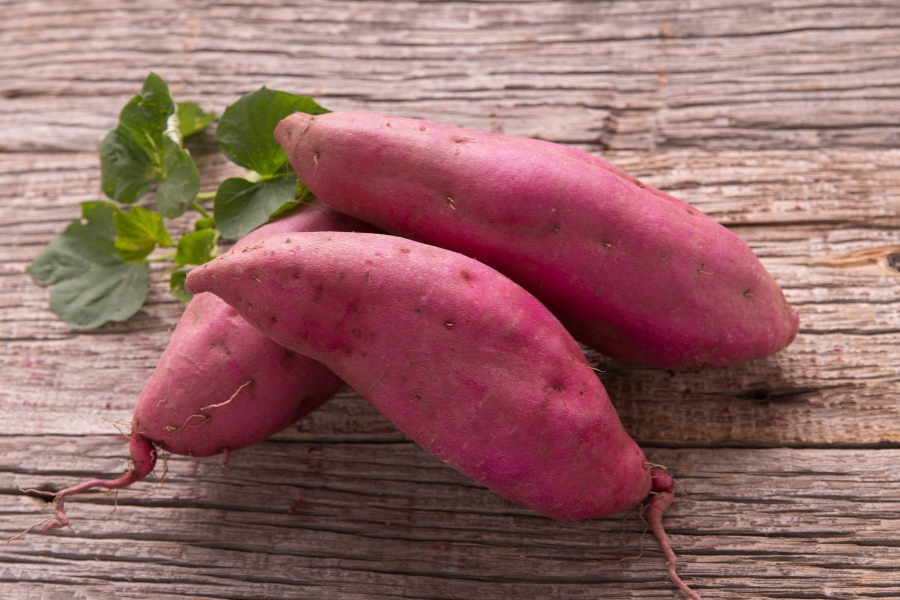
Sweet potatoes: benefits, uses, recipes and dosage for people with type 2 diabetes
Sweet potatoes have been a revelation in my journey with diabetes. They have a GI score that is generally lower than white potatoes, usually between 44 and 61, depending on the cooking method. This makes them a more blood sugar-friendly option for someone like me, looking to manage carbohydrate intake without sacrificing flavor or satisfaction.
Rich in vitamins A and C, manganese, and fiber, sweet potatoes not only support blood sugar levels but also provide a wealth of other health benefits. They are an excellent source of antioxidants, which can help reduce inflammation and protect against chronic diseases.
I find that sweet potatoes can be used in a myriad of ways in the kitchen. They can be roasted, mashed, baked, or even turned into noodles for a healthier twist on traditional pasta dishes. Their natural sweetness pairs well with a range of spices and flavors, allowing for culinary creativity while keeping health in check.
Benefits of sweet potatoes for type 2 diabetes:
- Fiber: Sweet potatoes are a good source of fiber, which helps regulate blood sugar levels by slowing down digestion and absorption of carbohydrates. This can be beneficial for people with type 2 diabetes as it helps to prevent blood sugar spikes.
- Magnesium: This mineral plays a crucial role in insulin sensitivity and blood sugar control. Studies suggest that adequate magnesium intake may improve insulin sensitivity and reduce the risk of developing type 2 diabetes.
- Vitamins: Sweet potatoes are loaded with vitamins, particularly vitamin A in the form of beta-carotene, which is essential for maintaining healthy vision and immune function.
- Antioxidants: These compounds help protect cells from damage caused by free radicals, which may play a role in the development of diabetes and other chronic diseases.
Uses of sweet potatoes for type 2 diabetes:
Sweet potatoes are incredibly versatile and can be enjoyed in various ways:
- Roasted: This is a simple and healthy way to prepare sweet potatoes. Simply cut them into wedges or cubes, toss them with olive oil and spices, and roast them in the oven until tender.
- Mashed: Mashed sweet potatoes are a delicious and nutritious side dish. You can mash them with butter, milk, or spices for added flavor.
- Fries: Baked sweet potato fries are a healthier alternative to traditional french fries. They are still crispy and delicious but contain less fat and calories.
- Soup: Sweet potatoes can be added to soups and stews for added sweetness and nutrients.
Sweet potato recipes for type 2 diabetes:
- Roasted Sweet Potatoes with Garlic and Herbs:
Ingredients:
- 2 medium sweet potatoes, peeled and cut into wedges
- 1 tablespoon olive oil
- 1/2 teaspoon garlic powder
- 1/4 teaspoon dried thyme
- Salt and pepper to taste
Instructions:
- Preheat oven to 400°F (200°C).
- Toss sweet potato wedges with olive oil, garlic powder, thyme, salt, and pepper.
- Spread on a baking sheet and roast for 20-25 minutes, or until tender and golden brown.
- Sweet Potato and Black Bean Burgers:
Ingredients:
- 1 large sweet potato, roasted and mashed
- 1 can (15 oz) black beans, rinsed and drained
- 1/2 cup breadcrumbs
- 1/4 cup chopped onion
- 1 egg, beaten
- 1 tablespoon chili powder
- 1/2 teaspoon cumin
- Salt and pepper to taste
Instructions:
- Combine all ingredients in a large bowl and mix well.
- Form into patties and cook in a skillet over medium heat for 5-7 minutes per side, or until cooked through.
Dosage of sweet potatoes for type 2 diabetes:
It is important to note that there is no specific “dosage” of sweet potatoes recommended for people with type 2 diabetes. The amount you can eat will depend on your individual needs and diabetes management plan.
It is crucial to consult with your doctor or a registered dietitian to determine the appropriate amount of sweet potatoes to incorporate into your diet. They can help you create a personalized meal plan that considers your overall health and diabetes management goals.
Oats: benefits, uses, recipes and dosage for people with type 2 diabetes
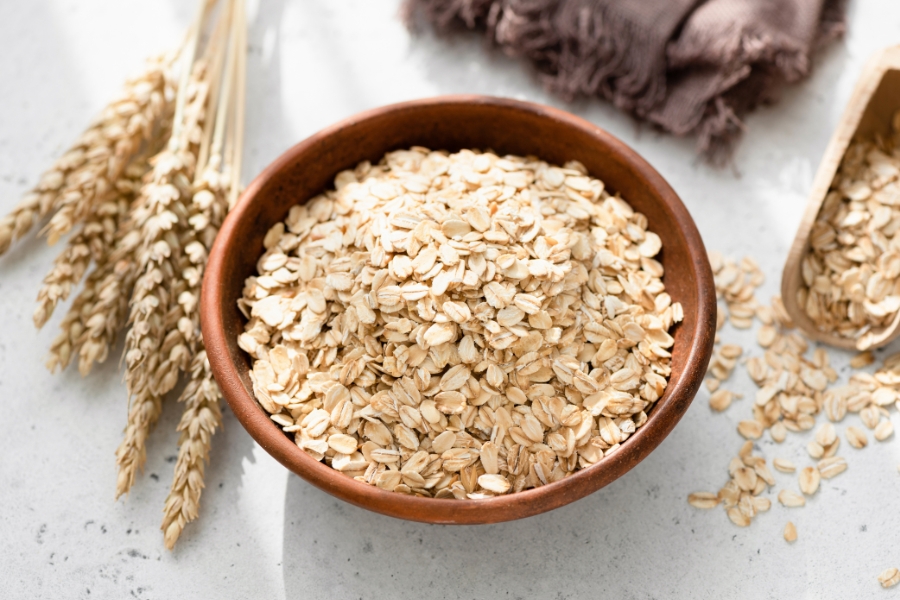
Oats: benefits, uses, recipes and dosage for people with type 2 diabetes
Oats are a staple in my breakfast routine for several reasons. They have a low GI score, typically ranging from 49 to 55 for rolled oats, and are a fantastic source of soluble fiber, particularly beta-glucan, which has been shown to improve insulin sensitivity and lower blood sugar levels.
Starting my day with oats sets me up for success by providing me with long-lasting energy and helping to regulate my blood sugar levels throughout the morning. Oats are also incredibly heart-healthy, as they can aid in lowering cholesterol levels.
The beauty of oats lies in their versatility. They can be prepared as oatmeal, added to smoothies for a fiber boost, or used in baking. I enjoy experimenting with different toppings and mix-ins, such as nuts, seeds, and the aforementioned berries, to keep my breakfast exciting and nutritious.
Benefits for Type 2 Diabetes:
- Blood Sugar Control: Oats are rich in soluble fiber, particularly beta-glucan, which slows down carbohydrate digestion and absorption, leading to a gradual rise in blood sugar compared to refined carbohydrates. This is reflected in their low glycemic index (GI), making them a suitable choice for people with type 2 diabetes.
- Improved Insulin Sensitivity: Studies suggest that regular oat consumption can enhance the body’s ability to use insulin effectively, further contributing to better blood sugar control.
- Heart Health Benefits: Oats are a good source of heart-healthy fiber which can help lower LDL (“bad”) cholesterol levels and improve overall cardiovascular health, a crucial aspect of type 2 diabetes management.
Uses and Recipes:
Oats are versatile and can conveniently be incorporated into many different meals throughout the day:
- Breakfast: Oatmeal is a classic choice, but you can also try oat bran muffins, overnight oats, or smoothies with rolled oats.
- Lunch/Dinner: Add cooked oats to savory dishes like soups, stews, or veggie burgers for added fiber and texture.
- Snacks: Enjoy baked oat bars made with minimal added sugar or raw rolled oats with a sprinkle of nuts and cinnamon.
Considerations and Dosage:
- While oats are generally beneficial, it’s important to monitor portion sizes. A typical serving of dry oats is around 1/2 cup, which translates to roughly 30 grams of carbohydrates. This amount can be adjusted based on individual needs and dietary plan.
- Be mindful of added sugars and toppings. Opt for natural sweeteners like fruits or spices instead of processed sugar when preparing oatmeal. Avoid sugary toppings like jams, syrups, or chocolate chips.
- Consult with a registered dietitian or healthcare professional to determine the appropriate dosage of oats and how to best integrate them into your personalized diabetes management plan.
Remember, oats are just one piece of the puzzle. A healthy lifestyle encompassing a balanced diet, regular physical activity, and proper medication adherence is essential for managing type 2 diabetes effectively.
Delicious and healthy recipes using these low GI foods
I’ve discovered that eating low GI foods doesn’t mean sacrificing flavor. In fact, it has opened up a whole new world of delicious and healthy recipes. For example, a quinoa salad with roasted sweet potatoes, black beans, and a lime vinaigrette is a flavorful, nutrient-dense meal that keeps my blood sugars in check. Lentil soup with a variety of vegetables and a sprinkle of herbs is a comforting and blood sugar-friendly option on a chilly day.
Berries can be turned into a delightful compote with a touch of cinnamon, perfect for topping oatmeal or yogurt. And for a satisfying snack, roasted chickpeas with a sprinkle of sea salt and paprika offer a tasty, low GI alternative to processed snacks.
By incorporating these low GI foods into my recipes, I not only enjoy tasty meals but also reap the benefits of a diet that supports my diabetes management. It’s truly a win-win situation.
Conclusion: Empowering individuals with type 2 diabetes to make informed dietary choices
In conclusion, embracing low glycemic index foods such as quinoa, lentils, berries, sweet potatoes, and oats has been instrumental in managing my type 2 diabetes. These foods provide the balance and nutrients needed to maintain stable blood sugar levels, support overall health, and allow for culinary creativity.
Empowerment comes from knowledge and the ability to make informed choices. Understanding the role of the glycemic index and incorporating these low GI foods into my diet has been empowering for me, and I hope it will be for others as well.
For those of you with type 2 diabetes or those supporting someone with the condition, I encourage you to explore the world of low GI foods. You might be surprised at the variety and flavors available, all while keeping your health on track. Together, we can take control of our diets and our diabetes, one delicious and nutritious meal at a time.
















[…] Reducing belly fat goes far beyond fitting into smaller clothes or looking better at the beach. The benefits are profound and can have a long-lasting impact on your health and wellbeing. Reducing abdominal fat can lead to improved cardiovascular health by decreasing the risk of heart disease and lowering blood pressure. It can also improve metabolic health, reducing the likelihood of developing insulin resistance and type 2 diabetes. […]